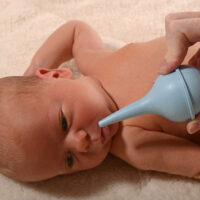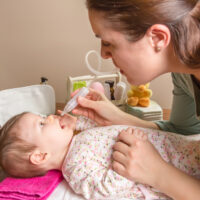A pacifier has a calming effect on our little ones and according to the American Academy of Pediatrics, it can even keep them safe while they are sleeping. However, most parents agree that keeping a pacifier in their baby’s mouth can be quite a struggle. With the regular lack of sleep that you get in the first six months of your baby’s life, the last thing you want to do is stay up all night to guarantee that their pacifier stays in place.
Top 5 Methods for Keeping a Pacifier in Place
Find the Right Fit

Style. Pacifiers are available with two main designs: the orthodontic nipple or the rounded tip nipple. The orthopedic version is constructed to more accurately match the shape of your baby’s mouth. The latter is, well, round.
No matter how much research you do on which version is better, your little one may prefer the alternative choice. Determining the style that your baby prefers is the first step in getting them to keep it in their mouth.
Size. While most pacifiers look the same, there are different varieties available for the age of your child. Soothies tend to be smaller and softer for younger infants and then become longer and firmer for the older kids. As they age, transitioning to the correct size is extremely important.
While they may prefer the softer texture, this option can suddenly become a choking hazard because it is more malleable and can therefore squeeze more easily into their mouth. Conversely, giving your child a pacifier meant for an older age group before they are ready can cause difficulties keeping it in their mouth due to their suck not being strong enough.
Teeth. What may be the perfect fit in your baby’s first few months of life can change drastically once their teeth begin to emerge. This means that their style preference could potentially switch at the drop of a hat. Having alternatives on hand can make for an easy fix!
Give It a Tug

Just like when you are breastfeeding, you want to establish a good latch. When you pop the pacifier in their mouth, immediately give it a good tug. This will cause them to readjust latch and suck a bit harder. In other words, reverse psychology at its finest.
If you make a habit of doing this each time you hand over their pacifier, they will slowly train themselves to keep it in their mouth more effectively.
Leave Some Spares in the Crib

A lot of times your baby will reposition themselves during the night. This can inadvertently push the pacifier out of their mouth. Once your child reaches a certain age, they are more than capable of putting it back in their mouth, if they can find it.
By placing multiple pacifiers in the crib, they will have an easier time locating another and putting it back where it belongs. Moreover, there are now glow-in-the-dark pacifiers that let both you and your child find their binky with little fuss or light!
Address Underlying Issues

Sucking Ability. Some babies find it easy to latch. Others tend to struggle through the process. It may be that they just need time to build up their tongue strength or they could have a tongue tie. This will cause issues with using a pacifier as well as with feeding in general.
Be patient and try to work with your baby through these hurdles. If these problems persist, consider talking to your pediatrician about solutions.
Other Distractions. You want to avoid your baby associating the pacifier with negative situations. Many parent’s immediate reactions to a screaming baby are to give them their binky to get them to calm down. Unfortunately, if the underlying cause is something else, they will not only spit it out, but they can start to identify the pacifier as a bad thing.
Let’s face it — no one can really concentrate when they are hungry or have to go to the bathroom. If your little one sometimes takes the pacifier with no issue whereas other times they seem to struggle, there could be another factor causing the refusal.
Our baby’s main job in the first year of life is to triple their birth weight. They will go through many growth spurts and those can trigger behavioral changes and alter the amount and timing of their feedings.
See if they want another bottle before bed or prior to their nap. Check that their diaper is clean! Consider that they could be teething and pressure on that soon-to-be pearly white could just be causing them pain. If that is the case, then a teether may be a better option at that time.
Continue Use During the Day

Practice makes perfect, right? The more they use it, the more accustomed they will become to it staying in their mouth. Focus on giving them the pacifier after feedings to ensure that it doesn’t hinder their eating habits. Moreover, only offer it to them when they are happy or sleepy. We want the connotation to be that the pacifier is a good thing.
If they are not a fan, consider putting it in their mouth the moment they have finished their feeding. Many times babies will continue sucking on an empty bottle and this quick switch is a sneaky way of getting them to take the binky without realizing it.
Benefits and Safety of Pacifier Use
Sudden Infant Death Syndrome, or SIDS, is the leading cause of death in children less than one year of age. This condition kills an average of 3,500 healthy children each year. It normally happens when the child is asleep and unfortunately, doctors still do not know the cause.
However, there is one thing that is perfectly clear — pacifier use saves lives. Recent studies have determined that by giving your baby a pacifier at night, you reduce your baby’s risk of SIDS by 90%. Why? It is theorized that when your child is sucking on a pacifier, there is better airflow and less of a threat that their throat will become obstructed by their tongue. Furthermore, most pacifiers have a bulky grip, which helps to create a barrier between your baby’s airways and their bedding.
This scary condition is most likely to occur between 2 to 4 months of age. The chances start to lessen after 6 months and virtually disappear after they turn one. Doctors recommend pacifier use during this time frame for this reason.
However, if you plan to breastfeed, lactation specialists advise that you wait until the one-month mark to pop in the pacifier, as it could cause nipple confusion. There are also a variety of options that are better suited for breastfed babies if this is a concern.
Things to Avoid
Attachments
Pacifier clips and pacifiers with toys attached are fantastic options during the day. However, these products should NEVER be used when you put your child down for a nap or to sleep for the night.
If the toys become positioned over their nose or under their throat, this can lead to suffocation. Furthermore, pacifier clips are normally short to prevent them from wrapping around a child’s neck. Nevertheless, if positioned in the wrong way during sleep, they can still pose an asphyxiation threat.
Tucking
Many parents instinctively think that if they tuck the pacifier into the swaddle or their baby’s clothing that it will hold it in its rightful place. Unfortunately, this can be a very dangerous mistake. If your child were to spit up in the night, then they would have no way to push out their binky. This could lead to them choking on their own vomit, which could be deadly.
Sugar Coating It
A spoonful of sugar may help the medicine go down, but it also likely guarantees that your baby will develop cavities. Contrary to popular belief, those baby teeth are extremely important! They set the foundation for your child’s adult teeth. That means we want to take care of them!
FAQs about Baby Pacifiers
If my baby spits out his or her pacifier, should I keep putting it back in their mouth?
The first time they spit out the pacifier, put it back in their mouth, give it a tug and let them go back to sleep. However, if your baby does not want it, then don’t force it. There are extreme benefits to pacifier use in regards to SIDS, but remember that there are other methods to help prevent this horrible syndrome.
Keep your baby’s crib bare — no toys or blankets. Put them to sleep on their back. Keep them in your room for the first six months so that you can better monitor them. Many doctors recommend breastfeeding and immunizations to help prevent SIDS as well.
Keep in mind that there are a lot of reasons why your baby may not want the pacifier at that moment. Be patient and always follow their cues. Working with them over time can help them get used to sucking on one while they sleep.
How long can my baby use a pacifier?
The American Academy of Pediatrics recommends that you start to wean your baby off of the pacifier after six months of age. This is the time frame that the risk of SIDS decreases and the occurrence of ear infections increase. Pacifier use has been shown to cause an added chance of inner ear infections due to the regular opening of the auditory tubes from steady sucking.
If you do choose to let your child continue pacifier use for a longer period, the American Academy of Pediatric Dentistry advises not continuing past 36 months. Extended use can alter the shape of your baby’s mouth and hinder the development and alignment of their baby teeth.
How often should I clean the pacifier?
It is a good practice to clean your baby’s pacifiers once daily. This helps to prevent the growth of germs that could make your baby sick. Not only that, but it gives you a chance to regularly inspect their binkies. This is exceptionally important because if you have a pacifier made of multiple parts, it can become loose over time. This can become a choking hazard, therefore regular examination is recommended.
Sterilize all pacifiers before their first use. After that, dish soap and hot water are a perfect way to keep them clean. However, the orthodontic varieties can get soap and water trapped in the nipple due to their built-in ventilation design. If this occurs, pinch down on the nipple and rinse again. Once the soap is gone, shake the pacifier, while still pinching down to remove any excess water.
How often should I replace my baby’s pacifier?
A pacifier needs to be discarded at the first sign of weakness or damage. However, whether or not damage has occurred, it is a good practice to replace your child’s binky every one to two months. Moreover, check the recommended age guidelines for your specific brand and transition when advised.
Final Thoughts
Pacifiers are a fantastic option to soothe your baby whether they are tired, colicky, or teething. They can also help ensure that your child stays safe at night. There are many pros and cons to pacifier use so you will have to decide what is best for you and your baby.
Not every baby is going to take a pacifier, but there are easy methods to help them get accustomed to using one and to keep it in their mouth while they sleep. Having multiple designs and brands at your fingertips can be a beneficial first step when your child is being indecisive about their preference. Most importantly, follow your baby’s cues! They will let you know what they need and when they need it.






